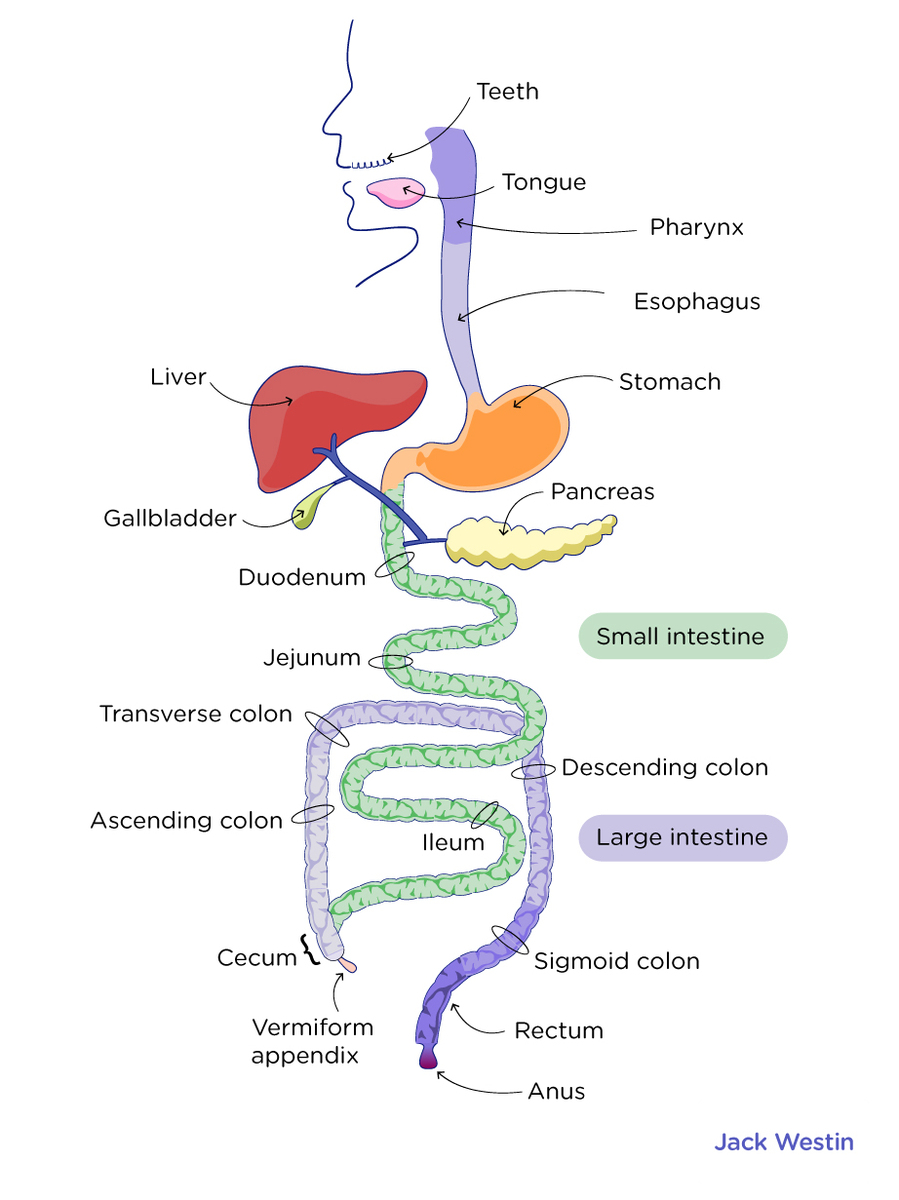The stomach is a significant part of the digestive system for mechanical and chemical digestion of food. The stomach secretes gastric digestive juices, contains enzymes and often stores food for some time.

The stomach is a saclike organ present next to the esophagus. The bolus from the esophagus enters here. The stomach secretes gastric juice that has a pH between 1.5 and 2.5. This highly acidic environment is required for the chemical breakdown of food and the extraction of nutrients. The stomach also contains smooth muscle which helps in mechanical digestion known as the churning of food.

The stomach secretes various enzymes such as pepsinogen which is converted to pepsin when mixed with the stomach acid. Pepsin begins the break down of proteins. The gastric enzyme lipase is also present in the gastric secretions that help in the digestion of fats/lipids.
The stomach also contains parietal cells, which secrete hydrochloric acid. As well as helping with chemical digestion and enzyme activation, the highly-acidic environment also kills many microorganisms in the food and, combined with the action of the enzyme pepsin, results in the hydrolysis of protein in the food.
The partially-digested food produced in the stomach and gastric juice mixture is called chyme. Chyme passes from the stomach to the small intestine; this movement is aided by the mucus/goblet cells in the wall of the stomach secrete mucus that lubricates the walls of the stomach and protects it from the acidic gastric juice.
The inner wall of the stomach has rugae (folds) that increase the surface area. It is a saclike or banana-shaped organ. It has a sphincter at the junction of the esophagus and stomach known as a cardiac sphincter that controls the entry of contents between the stomach and the esophagus. It has a sphincter at its junction with the small intestine known as a pyloric sphincter that controls the entry of contents between the stomach and the small intestine.
Practice Questions
MCAT Official Prep (AAMC)
Biology Question Pack, Vol. 1 Passage 2 Question 6
Practice Exam 4 B/B Section Passage 7 Question 37
Key Points
• The stomach is a saclike muscular organ that performs mechanical digestion of food by action of smooth muscles and chemical digestion by action of digestive enzymes in gastric secretions. It can also store food.
• The digestive enzymes secreted in the stomach are pepsinogen and gastric lipase. These are secreted by chief cells.
• The parietal cells secrete Hydrochloric acid that helps to convert inactive pepsinogen to active pepsin. This acid makes gastric secretion of low pH (pH 1.5 to 2.5).
• Pepsin digests proteins, and gastric lipase digests lipids.
• Goblets cells secrete mucus that provides lubrication to the stomach walls from acidic gastric secretions.
• The stomach has a cardiac sphincter at its junction with the esophagus and a pyloric sphincter at its junction with the small intestine that controls the entry of contents.
• The wall of the stomach has numerous fold known as rugae.
Key Terms
Smooth muscle: an involuntary muscle that contracts and relax to perform mechanical digestion in the stomach
Mucus: a slimy type substance that provides lubrication
Chemical digestion: the process of enzymes breaking down food into small molecules the body can use.
Lipase: enzymes in the pancreatic juices that break down lipids.
Mechanical digestion: the physical breakdown of large pieces of food into smaller pieces which can subsequently be accessed by enzymes.
Sphincter: a circular muscle present at a passage of opening that contracts and relax to open and close the opening
Esophagus: a tube-like muscular organ that transports the bolus to the stomach for further digestion
Pepsinogen: protein digestive enzyme secreted by the gastric chief cells as a proenzyme and then converted by gastric acid in the gastric lumen to the active enzyme pepsin
bolus: a semi-solid mass of food formed due to mastication by the action of teeth, tongue, and saliva
pepsin: an enzyme that digests proteins to amino acids
parietal cells: cells that secrete hydrochloric acid (HCl) located in the wall of the stomach
chyme: the partially-digested food produced in the stomach and gastric juice mixture









